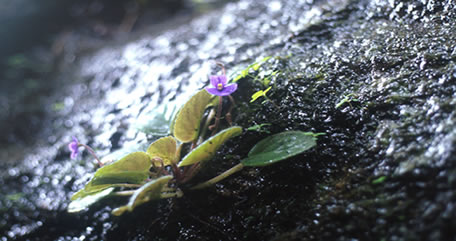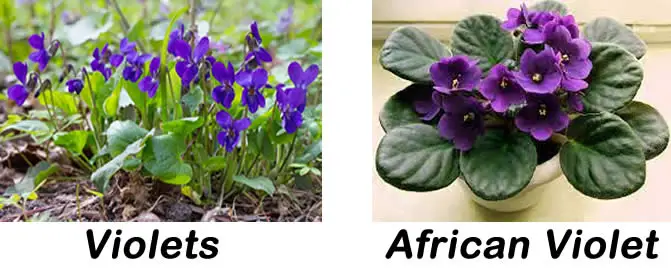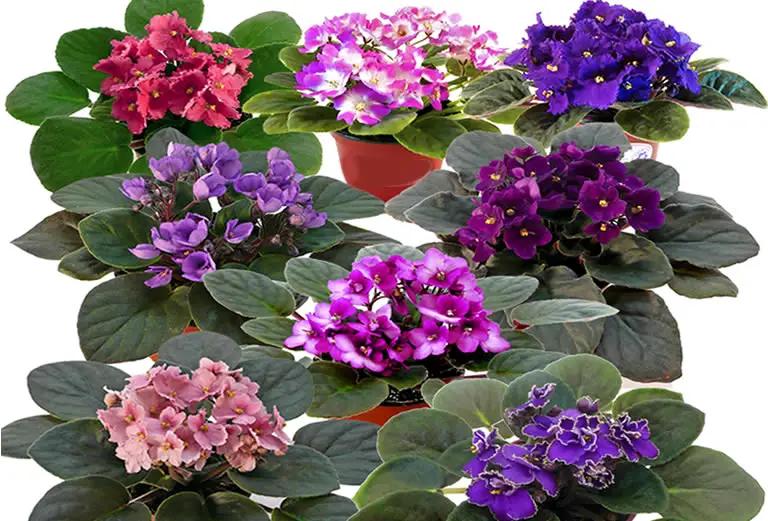In this article I cover the basics of the African violet and give you a some good care tips also. This flowering plant is mostly grown as a houseplant. It is very popular across the US as it is an easy-care plant that requires very little maintenance and flowers continuously.
Table of Contents
- The native habitat of the African violet is not where you think it is
- African violets are not actually violets
- The huge difference between violets and African violets
- The African violet is a tropical plant
- The natural lifespan of African violets is decades
- African violets are easier to care for than most people think
- African violets do not like to be root bound
The native habitat of the African violet is not where you think it is
If you have never seen an African violet or are unsure of what it is, I will give you a brief outline of this plant.
An African violet, scientific name Saintpaulia, is a flowering plant that grows natively in parts of Africa. It belongs to the family Gesneriaceae. They grow between 6 – 11 cm tall and 6 – 30 cm wide. It has rounded hairy leaves. Its flowers are 2 – 3 cm wide with 5 petals and grow in clusters on thin stalks. The flowers come in a variety of colors.
African violets grow naturally in Tanzania, southeastern Kenya and the tropical parts of east Africa.

Unfortunately though, more and more land is being cleared for agriculture in the native environment where African violets grow, this means those areas are becoming eroded and this is causing some of species of African violet to become endangered.
There is some good news though as a new species of african violet was found in Mizoram in 2021.
African violets are are most commonly grown in the US as a houseplant.
African violets are not actually violets
So now that you know what African violets are, you may be wondering if they are actually a member of the violet family.
African violets are not actually violets. They are named because their appearance resembles violets. African Violets are from the family Gesneriaceae, Saintpaulia to be exact, while violets are from the family Violaceae, Vola to be exact. The care requirements of violets and African violets are different.
It is due to the fact that an African violet looks, at least superficially, similar to a violet that the plant got its common name.
However, African violets are members of the family Gesneriaceae that consists 152 genera, which itself has about 3,540 different species of plant. African violets belong to Saintpaulia which belongs to the subgenus Streptocarpella, and has about 10 species of plants.
The huge difference between violets and African violets
If African violets are not actually violets then what is the difference between the two plant types?
Violets belong to the family Violaceae while African violets belong to the family Gesneriaceae. Violets grow in the temperate Northern Hemisphere while African violets are tropical plants that grow natively in Africa. African violets got their name due to their superficial resemblance to violets.
Although both violets and African violets are perennials and their flowers look somewhat familiar, this is where the similarities end.
 Violets and African violets are completely different plants that require different care routines.
Violets and African violets are completely different plants that require different care routines.
Where African violets prefer a warm humid environment, like their native cloud forest habitats in Africa, violets prefer a temperate climate.
The African violet is a tropical plant
So what type of plant is an African violet exactly?
African violet, Saintpaulia, is a tropical flowering plant native to parts of Africa. It belongs to the family Gesneriaceae. It grows natively in cloud forest habitats and is commonly grown as a houseplant. There are about 10 species of african violet. It is a perennial though the plant flowers continuously for 10 – 12 months of the year
As they hail from the foggy cloud forests in Africa, African violets prefer a warm humid atmosphere. This means most homes are perfect for growing African violets, though in homes that have very dry air some additional steps need to be taken to create local humidity around the plant. I will cover this later in this article.
African violets got their scientific name, Saintpaulia, from the German colonial official Baron Walter von Saint Paul-Illaire, who sent back African violet seeds to his father who was a botanist. He is also responsible for the plant being called called a violet because he thought it resembled one due to its blue color.
The natural lifespan of African violets is decades
How long does an African violet plant live and how long can you expect your blooms to last?
You can expect a well cared-for african violet to live for several decades. Some owners have been growing the same african violets for 50 years while there are experts who claim that african violets can live indefinitely. An African violet flower will live for 2 – 3 weeks but the plant blooms continuously.
According to the Bay State African Violet Society, African violets can live indefinitely when given the proper care. It should therefore not come as a surprise that there are African violet owners who claim their plant has been alive for over 50 years.
African violets, being a tropical plant, prefer to live in temperatures that are between 65°F – 75°F (18°C – 24°C). And, although certainly not preferable, African violets can survive temperatures up to about 90°F (32°C).
On the flip side, African violets will not survive temperatures below 50°F (10°C).
Most home temperatures will be more than sufficient for African violets but if the air in your home is particularly dry then you will want to place your plant pot on a tray filled with pebbles and a little water.
One of the most common causes for the death of an African violet is overwatering so you must be sure you get your plant’s watering routine right. Read our guide on African violet watering for more information.
African violets are easier to care for than most people think
African violets are an easy-care plant but how exactly do you take care of one?
Here are 8 easy care tips for taking care of an African violet:
- Ensure your African violet gets only indirect sunlight. See my guide to African violet light requirements.
- It should be grown in a shallow but wide pot for healthy root growth.
- Use the correct type of soil. It should be slightly acidic and have a mix of peat moss, vermiculite and perlite.
- Keep the soil moist but not drenched.
- Water the plant only when the soil dries out.
- Normal household temperatures are perfect for African violet.
- If your home has particularly dry air then place the potted plant on a tray filled with pebbles. Add water to the tray to help create local humidity around the plant.
- Remove dead leaves and flowers as they die.
Perhaps the most important thing to consider when caring for African violets is the plant’s watering routine. Although African violets like moist soil they will not respond well if they sit in water. Overwatering an African violet will kill the plant. A sign of overwatering is drooping leaves.
If your African violet has healthy leaves and is flowering then you have a content plant. See my guide to caring for african violet leaves for more information on the care needs of an African violet.
African violets do not like to be root bound
There is a common belief among many indoor gardeners, and a few outdoor gardeners too, that African violets like to be root bound. Is this true?
African violets do not like to be root bound. Their roots grow outward rather than downward so they grow best in relatively shallow pots that are are wide than normal.
I grow African violets in shallow wide terracotta pots that offer the most room for root growth. Of course you can also use ceramic pots and I know a few people who grow their African violets in large glazed bonsai pots.
Why use a shallow wide pot?
As African violet roots grow from the center of the plant outwards, rather than downwards, it is better to give the plant a pot with a wider diameter as opposed to greater depth.
A traditional pot that is wide enough for healthy root growth will be very deep and although it is fine to grow African violets in one of these I just think a wider, shallower pot is more aesthetically pleasing and a better container for displaying African violets.

